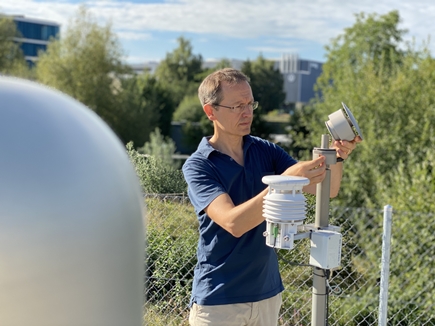Study on air pollution in Europe published in Nature
Particulate pollution re-evaluated
A study conducted across 43 European sites by an international scientific team coordinated by Université Grenoble Alpes, and with participation of researchers from Empa and the Paul Scherrer Institute (PSI), shows that the ability of airborne particles to generate oxidative stress in the lungs varies according to environmental type and emission sources. Notably, oxidative stress can be up to three times higher in urban areas with heavy road traffic than in rural regions. These findings, published in Nature, provide robust scientific evidence to support future European standards and inform public health policies.

Air pollution from particulate matter remains a major public health concern. While mass concentration levels are already regulated in Europe, the new European Air Quality Directive now also recommends monitoring the so-called oxidative potential (OP) of particles. This parameter indicates the capacity of particles to induce oxidative stress in the human body – a key mechanism in the development of respiratory and cardiovascular diseases. However, no limit values have yet been defined for OP. This international study proposes, for the first time on a large scale, exposure scenarios that could serve as a basis for setting future European standards.
The researchers compiled and analyzed nearly 11,500 OP measurements from 43 sites across Europe (urban, industrial and rural). Two standardized methods for measuring particulate OP were applied. This constitutes the most comprehensive database ever assembled on the subject.
The importance of reducing emissions from road traffic and wood burning

A strong spatial variability in OP was observed: Urban roadside sites exhibited levels up to three times higher than rural ones. Particles from road traffic and wood burning emerged as major contributors to the OP measured in the atmosphere. Simulations show that a reduction of at least 15% in emissions from each of these two sources would be needed to lower average urban OP levels to those observed in the least polluted urban areas. However, to approach World Health Organization (WHO) guidelines, projected mass concentration values would require a reduction of at least 65% in emissions from traffic and wood burning, respectively.
Landmark study to guide public health policies across Europe
This study provides the first large-scale harmonized database on the OP of ambient particles in Europe. The results suggest that monitoring OP, alongside particulate mass concentration, could significantly improve the assessment of population exposure to air pollution and help guide emission reduction policies more effectively. By proposing realistic exposure scenarios, the study lays a scientific foundation for establishing future regulatory values for OP. It represents a crucial milestone for implementing the revised European directive and shaping public health policies addressing the impacts of air pollution.
Coordinated by Gaëlle Uzu of the Institute of Geosciences and Environment in Grenoble, with Cécile Tassel, a PhD student at Université Grenoble Alpes, as the study’s first author, the research was supported by the Idex of Université Grenoble Alpes, the UGA Foundation, Prédict’air – Station of the Future Chair, the Air Liquide Foundation, the French national air quality monitoring system, the H2020-program, Actris-Fr, and the French Ministry for the Environment. Empa scientist Christoph Hüglin was responsible for the sampling and chemical characterization of the particle samples at the five Swiss sites of the study.
Cécile Tassel
Université Grenoble Alpes
Dr. Christoph Hüglin
Empa, Air Pollution / Environmental Technology
Phone: +41 58 765 4654
christoph.hueglin@empa.ch
Exposure Scenarios to Oxidative Potential of Atmospheric Particles in Europe; Nature (2025); doi: 10.1038/s41586-025-09666-9
-
Share






